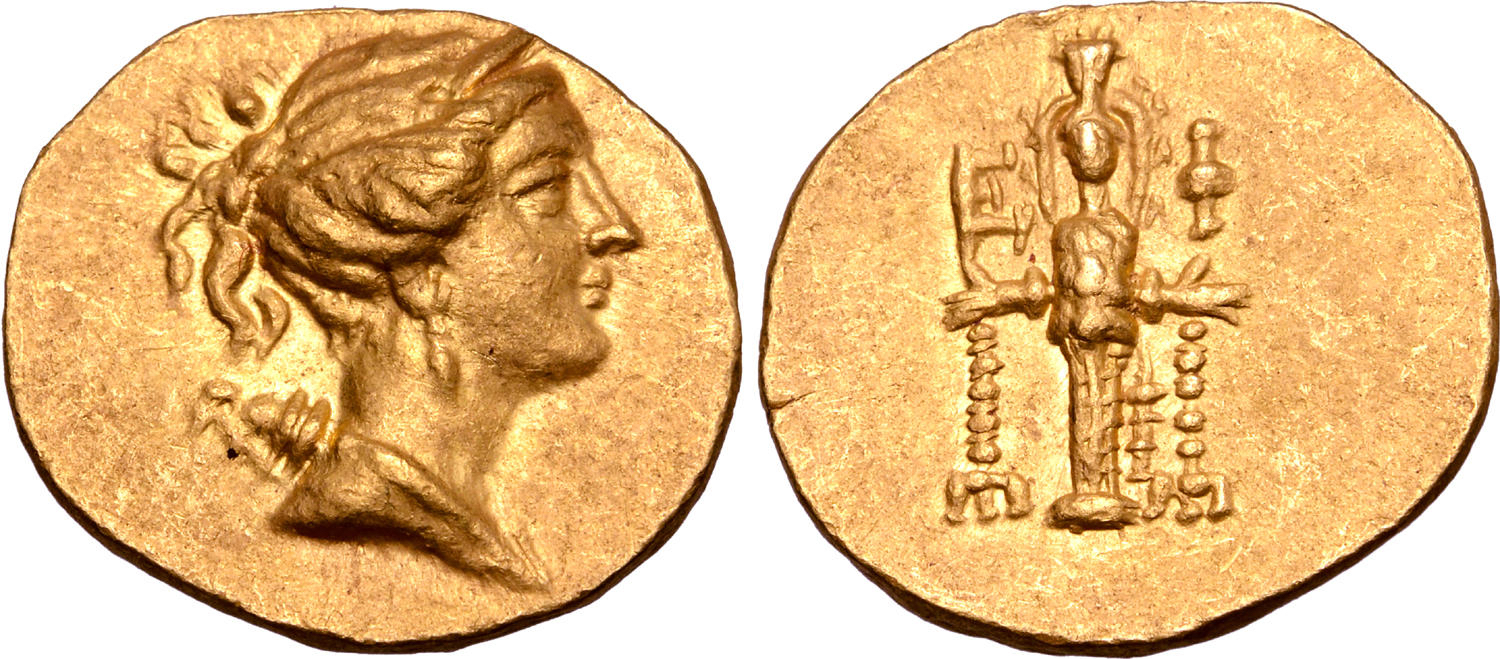
Ionia, Ephesos AV Stater. Circa 155-140 BC. Draped bust of Artemis right, wearing stephane, and with bow and quiver over shoulder / Cult statue of the Artemis of Ephesos facing, a fillet hanging from each hand; thymiaterion in inner right field, Ε-Φ across fields. G. K. Jenkins, Hellenistic Gold Coins of Ephesos, in Festschrift Akurgal, Ankara, 1987, p. 134, pl. B, 6 (BM) = R Fleuscher I, Artemis von Ephesos und der erwandte Kultstatue von Anatolien und Syrien, EPRO 35, 1973, pl. 53b; LIMC II, pl. 565, 23. 8.47g, 21mm, 12h. Extremely Fine. Very Rare. The Hellenistic era gold coinage struck at Ephesos is extremely rare and rarely well preserved. Previously thought to have all been struck during the Mithradatic wars, this is now known not to be the case. Some seem to be dated by the era of the Province of Asia and the dates they bear are too early for them to be Mithradatic War issues. Certain other issues such as the present example appear to be part of extraordinary issue of gold struck in conjunction with an extremely rare gold stater type of Magnesia in the mid-second century. The style and fabric of both issues seem consistent with an emergency issue struck to meet an immediate expense. The reverse of this coin depicts the famous cult statue of Ephesian Artemis, housed in the great temple of Artemis that is considered one of the Seven Wonders of the Ancient World. The original image of the goddess was a wooden xoanon that had represented a pre-Hellenic goddess who the Greeks later equated with Artemis. This first image, which was kept decorated with jewellery, was possibly lost in a flood in the 8th or 7th century which destroyed the temple; excavations have discovered the tear-shaped amber drops of elliptical cross-section which must have dressed it. In circa 550 BC, when reconstruction of the temple was begun (partly financed by Kroisos), it was undertaken in grand style and was supposedly the first Greek temple to be built of marble. The wooden xoanon was replaced by a new ebony or grapewood statue sculpted by Enoidos, which presumably survived until the temple was again destroyed, this time by an act of arson on the part of one Herostratos. The second destruction of the temple coincided with the birth of Alexander the Great; Plutarch later noted that Artemis was too preoccupied with Alexander's delivery to save her burning temple. The form of the goddess is distinctly near-eastern in appearance; characteristics such as her legs being enclosed in a tapering pillar-like term are closely related to Egyptian and Hittite images, and the curious feature of the many protuberances on her chest (usually described as breasts or eggs) are decidedly non-Greek in origin, and indeed have defied explanation or identification for centuries, though an association with fertility seems implicit.
Author: Ionia, Ephesos | Date: 155-140 BC

